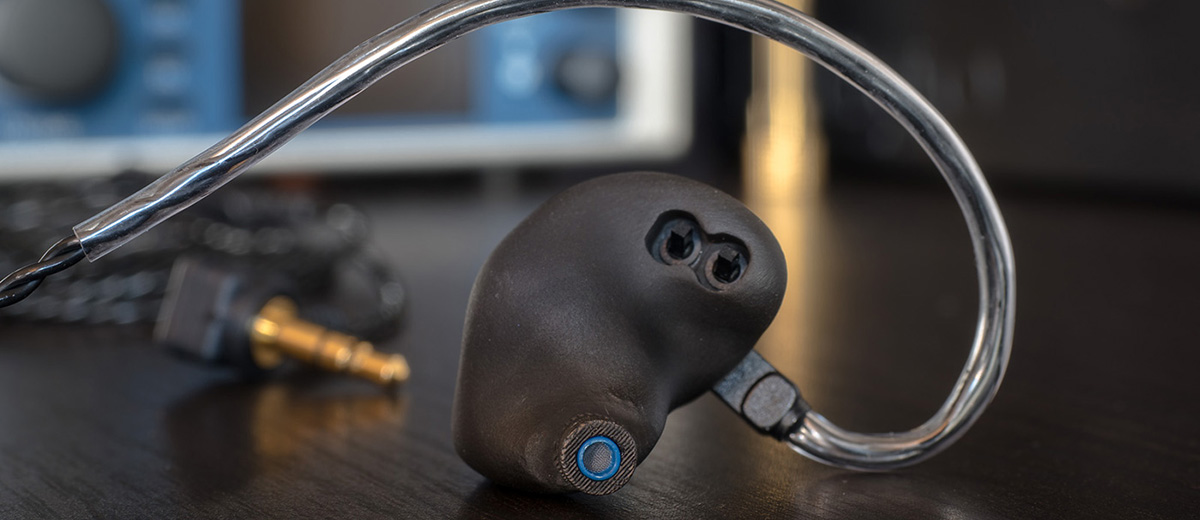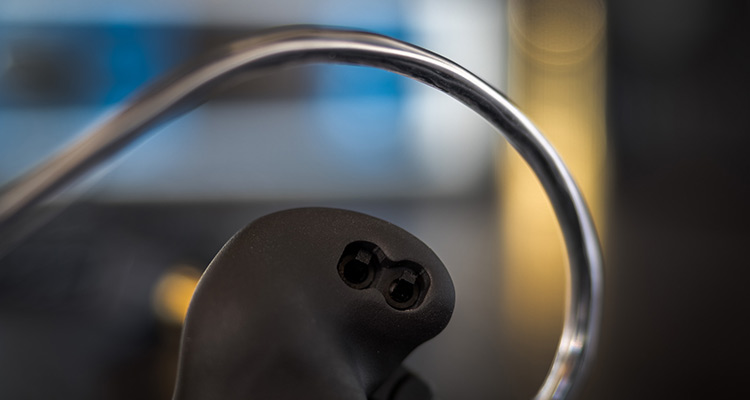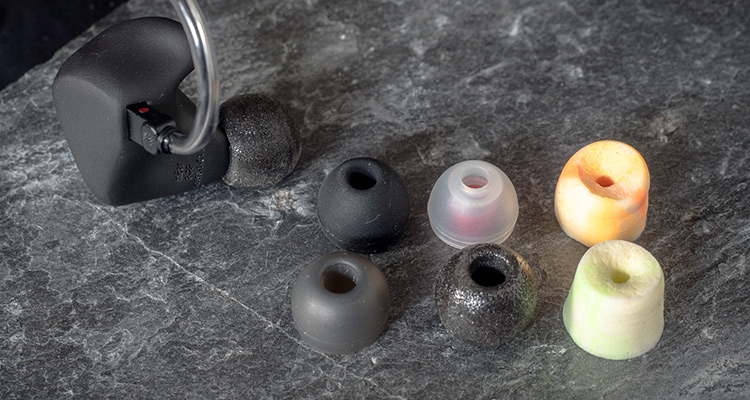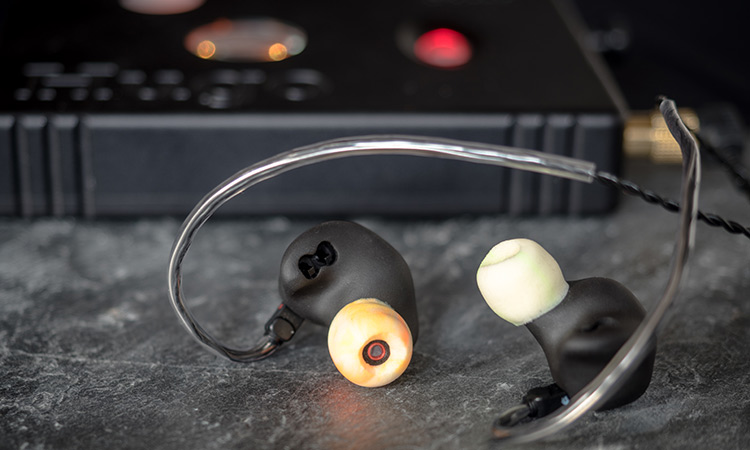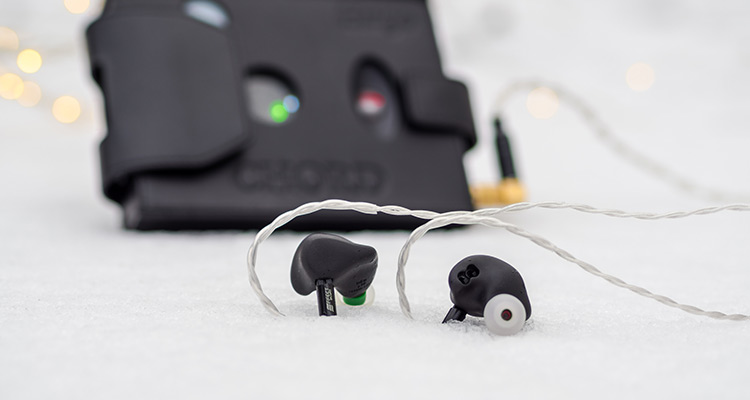Tweaking the Sound
Making Use of the Sound Switches
At this point, you should have noticed that I am fully impressed with the ProPhile 8. So what should I do with the two switches that adjust the sound signature? Let’s have a closer look first.
On the inside of the cymba part of the earphone, you will find two indented switches. The left one is for bass and the right one is for treble. Flipping the switch up means that you boost either part of the frequency range. Imagine a frequency graph with bass on the left and treble on the right. Analogous to the response graph, the switch’s position will quickly remind you if one is boosted. So how does either switch affect the sound performance?
The Bass Switch
InEar claims the bass switch boosts the lower frequencies by 3 dB. This is mostly correct. The bass boost picks up slowly between 300 – 100 Hz. 100 Hz and below it adds exactly 3 dB. But I also noticed it additionally recessed the midrange up to 1 kHz very slightly. Indeed, I perceive the bass boost as a very slight loudness tuning instead of simply adding bass impact and punch. None of the bass qualities suffer, though overall volume and rumble increase noticeably. There is but very little warmth added; mostly voices show only little coloration.
Precise
The bass switch does not turn the PP8 into the StageDiver 3 or something that resembles the thickness of the Sennheiser HD 650. The switch mostly pronounces only the lower bass lines and thus I’d not consider the bass switch as a new sound signature. Bassheads might regret the absence of a full-bodied, juicy, slow, rumbling beat – the PP8 are all about precision and detail and the bass boost does not change that. Do not expect similar rendition to a dynamic driver!
Apart from giving Hip-Hop Beats and Electronica some more oomph, the bass boost works best for me when commuting. It helps to even out low background noise from streets, busses, trains or other machinery to some extent. This also helps you to turn down the volume in quiet surroundings. It is definitely a great option to have, but the bass switch does not turn the PP8 into a totally different monitor.
The Treble Switch
InEar claims the treble switch boosts the higher frequencies by 2 dB. This is exactly what we measured, too. The treble boost does not suddenly kick in but starts a slow upward slope from 6.5 to 7.5 kHz. After that you have effectively 2 dB more pressure compared to the default setting – no peaks added! The treble performance is just as smooth and transparent as before, leaving mids fully intact. The overall sound is simply just a little bit brighter.
If you think you can easily tell a 2 dB difference, think again. Sound pressure is measured logarithmically, meaning a 1 dB difference is not audible for most people. While 2 dB are easier to notice, it will take some attention and careful comparison. I thus refer to the treble switch as the audiophile switch. It caters to the very attentive listeners that might possibly adjust their IEM to the source
Ideal Scenario
I don’t mind the treble boost at all for clean recordings or most Classical or Jazz. However, I don’t need the treble boost for this kind of recordings either. I actually think Rock and Pop work better without the treble boost. I thus keep it deactivated. But, apart from personal preference, the switch is very handy to have if either your source amp has a warm character or if you enjoy vinyl rips that often have a darker sound.
Also, it helps to counteract the secondary effects of Comply foam tips, for example. Finally, I can imagine that some on-stage musicians might slowly suffer from hearing loss – some extra treble might be very useful to have. Nevertheless, the treble switch is not one that you will keep turning on or off. I expect you will choose your preference once and stick with it eventually.
The Loudness Function
Obviously, flipping both switches up results in a bass and treble boost. As already mentioned, the bass switch works as a loudness tuning on its own. The effect becomes stronger with both switches turned on. I have absolutely no doubt that many users will not only like but actually even prefer this setting to the default one. The two switches create a deeper soundstage with more distanced mids, yet voices remain uncolored. Bass is never overpowering, mids aren’t bloated or muffled and there are no treble peaks to be heard. This is a true audiophile balanced signature!
The balanced ProPhile are not one of the wowing kind. They do not feature an exaggerated v-shape or one that will present music in a way you have never heard before. The tuning remains very, very mature. Musicality comes mostly through the transparency alone, depending on the recording. Even with activated bass and treble boost the ProPhile 8 remain usable for precise monitoring. This is what a balanced signature should sound like! InEar shows how to avoid noticeable coloration but still adding some energy at the very top and bottom ends for a livelier sound without causing fatigue.
Afterthought on the Sound Signature Switches
Truth be told, on the next day, I sometimes forgot in which setting I was using the PP8. All of the four options still unmistakably sound like from the same earphone. The bass boost is the easiest to uncover, the other options will require you to know your music and source very well.
When do I use them?
Having these options, I do want to use them. Before I get on the bus, I add some low-end; when I use the NOS filter on the ADI-2 Pro, I will activate the treble boost to counterweight the treble roll-off; or when I need a quick music fix, I will opt for the loudness setting.
Unfortunately, in the majority of cases, I think it’s not worth the trouble to pull out the tool to activate the switches. If I really want to focus on the music alone, when I demand full transparency, I make sure all switches are down anyway. This is the setting I use 95% of the time.
Yes, sure, both switches have a raison d’être. But I feel like one could have made even better use of them. For one, the ProPhile not only wants to cater to hifi enthusiasts but also professionals. Personally, I prefer the Etymotic ER4 XR over the bass-shy SR. The XR have a similar bass quantity as the PP8, but that does not deter from the fact that many professional sound engineers are accustomed to the flat ER4 S and SR sound.
Studio Use
In a studio environment, I thus think it would have made more sense to have the bass quantity in line with the Ety studio reference and use the bass boost to jump to the level which is now default. This would have resulted in the PP8 creating two monitoring references in one single IEM, completely eradicating the use of a second monitoring IEM.
Likewise, the treble switch is very delicate and its use is very limited. For me, the treble quantity is just right on default. Many users prefer a little roll-off in the treble which characteristic the PP8 does not show. But never does the treble sound harsh and thus I don’t see a reason for that option either.
Instead, I could imagine that for mastering audio it could be useful to avoid sibilance and thus using the treble switch to deliberately pronouncing harsh treble. This could be done by creating narrow peaks in the upper midrange and higher frequencies, for example, 5 kHz and 7 kHz. Of course, this is nothing that would sound enjoyable, but it would have a practical effect at least.
Take this as a minor criticism. Apart from the fact that the implementation of my ideas of redefining the switch’s purposes could be near impossible to achieve, the same effect can easily be done by DSP on almost any computer or smartphone instead.
As the switches are now, targeted at audiophiles and based on my personal application, I mostly either flip both switches or ignore them completely. There is little reason for me to only boost either end of the frequency range.
Is a single Switch Better?
Theoretically, InEar could have saved space and manufacturing costs by just using a single switch for loudness. The past has shown that InEar is motivated to improve the technical layout to create the same sound in a smaller shell as previously has been the case with the StageDiver S series. To make all the drivers, crossovers and switches of the PP8 fit into a smaller housing, I can imagine that they might either drop the switches or limit them to a single one instead.
However, production of a ProPhile S is not confirmed and might not happen at all. If there is a custom version coming, as has also been the case with the LivePro series that is based on the StageDiver designs, it would be questionable if the tuning switches would be optional or perhaps could be dropped to save a few bucks. Only time will tell.
Further Sound Enhancements
With a tuning so close to perfection and a reference sonic performance, one starts to wonder how much you can push the sound quality even further. So I did. I noticed that various ear tips change the sound performance noticeably as the ProPhile really pushes the user to find the perfect sweet spot.
Choice of Ear Tips
The default black silicone ear tips have a very grippy texture that allows great impact on bass performance. They also easily show ear wax and even though my ears should be clean most of the time, I noticed I had to use a handkerchief to wipe them clean after almost every use. Sonically, I noticed they very slightly lower the vocal presence for a more relaxed presentation.
Comply
InEar also includes a full set of Comply TS-400 foam tips. These allow high comfort and they make it very easy to achieve a full seal while not bothering with ear pressure. Bass loses some of its impact, though, and the overall sound signature takes a slightly warm tilt. The sound signature becomes very consumer-friendly and smooth.
UE Silicone
The Ultimate Ears silicone tips that are also included with the UE900 are my favorite choice for the StageDiver 2. The opening is bigger than the default tips which allows the treble to breathe more freely and also brings the mids more forward, almost to the extent of sounding honky. The surface is extremely smooth which does not hurt the bass’ speed but takes away some of its pressure. Instead, it pronounces punch some more. The overall sound signature becomes brighter but also takes away from the musicality. Fans of the Etymotic ER4 S or SR might prefer these or similar tips.
SpinFit
After I installed the SpinFit ear tips, they quickly became my preferred choice. They are not only comfortable, but their sonic impact is to my liking as well. Some of the bass’ warmth is evened out. Mids come out clear and they appear neither forward nor relaxed. Treble amount is just right according to my personal liking and I only rarely use the treble switch for Classical music.
Custom-Built Foams
For the users that want to go the extra mile, I have another recommendation: custom-built foamies. You can use soft earplugs by Ohropax, Bilsom, 3M, Merox, Wolfcraft, etc. and cut them short (approximately in half but some personal experimentation is recommended). Now put the two ends between two surfaces and flatten them. Finally, use a hole puncher in the middle. (If you have questions, please use the comment section, I’ll be happy to help you out.)
The main advantage for me is that you can achieve deeper insertion because the self-made foam tips are hardly longer than the nozzle of the IEM whereas the Complys stick out a lot. This way the ProPhile is as close to the outer ear as possible and almost resembles a full custom. They also have by far the best isolation of any other tip and come extremely close to the seal of a CIEM if not even match it. (Depending on which manufacturer you choose the durability should be multifold that of Comply.)
The seal should not break with jaw movement either. Treble is not distorted; bass impact is lost a bit but shows better texture. Overall the soundstage closes in a step for more intimacy. The sound signature is the most neutral in this setup and I recommend this mod over the UE tips for fans that are searching for the best possible monitoring solution.
Upgrade Cables
Default
The included cable by Plastics1 is the default choice of most CIEM manufacturers for a reason. It is very reliable and in over 5 years of using them, I haven’t had a single cable break on me yet. So obviously the ProPhile 8 has been tuned with the industry standard in mind. But that doesn’t mean that there is no better to be found.
Now, there are far too many aftermarket cables to choose from. It would be unfair from me to recommend a single cable. But I do want to share my experience anyway. I have tried 8 aftermarket cables of which none are from the super high-end price point – most are very affordable and in relation to the PP8 retail price.
Aftermarket
The tested manufacturers included PlusSound, Rhapsodio, Forza AudioWorks, Linum and Effect Audio. All of them were measured between 1.5 – 1.7 ohms and thus exactly in line with the 1.6 ohms of the Plastics1 cable. Source for testing the cables was the Chord Hugo via HD-USB playing the same playlist over and over.
Based on my experience with other IEMs, I would rate PP8’s signature as very stable. The cables had less effect on the sound than when compared to other in-ears. Changes in audio were mostly minor. Without naming them, three of the bunch changed the sound for the worse, IMO. (Synergy is important, they can improve SQ with other IEMs, though.)
All others, except for a last remaining one, did not have any sonic impacts at all. Finally, the Effect Audio Thor Silver II put the focus more on mids and treble for smooth and transparent reproduction, better layering, higher dynamics and deeper soundstage. If you want to pair your set of PP8 with a new cable, I thus suggest to look into this direction and continue my research.
Click on page 3 below for Matching & Comparisons

